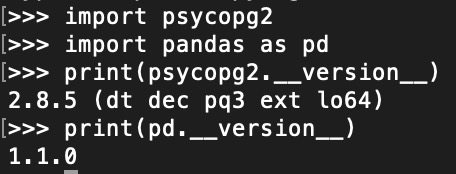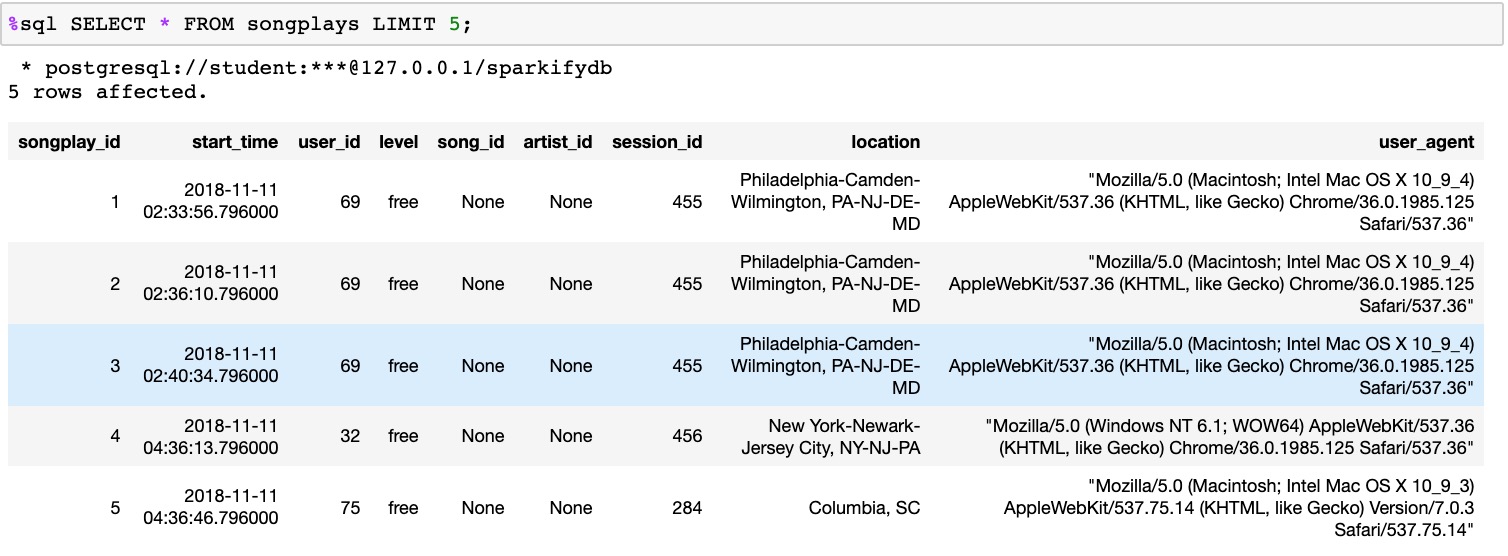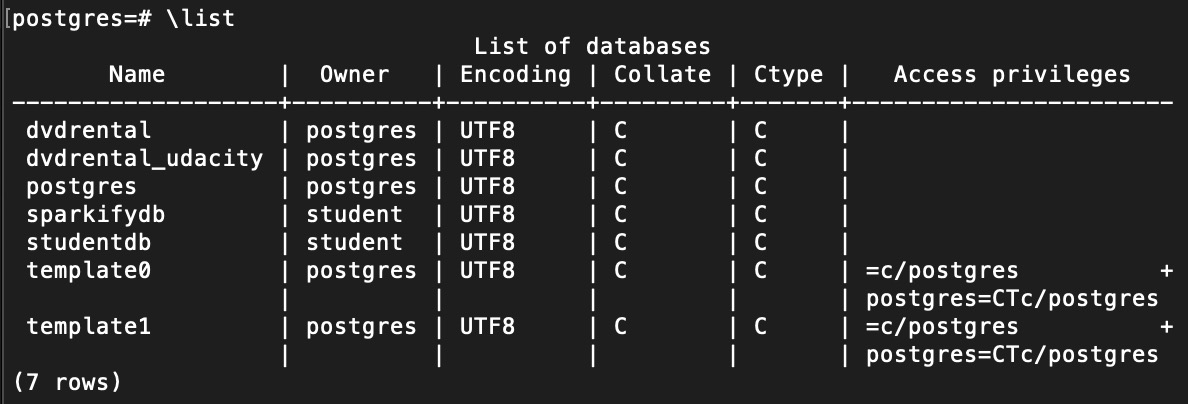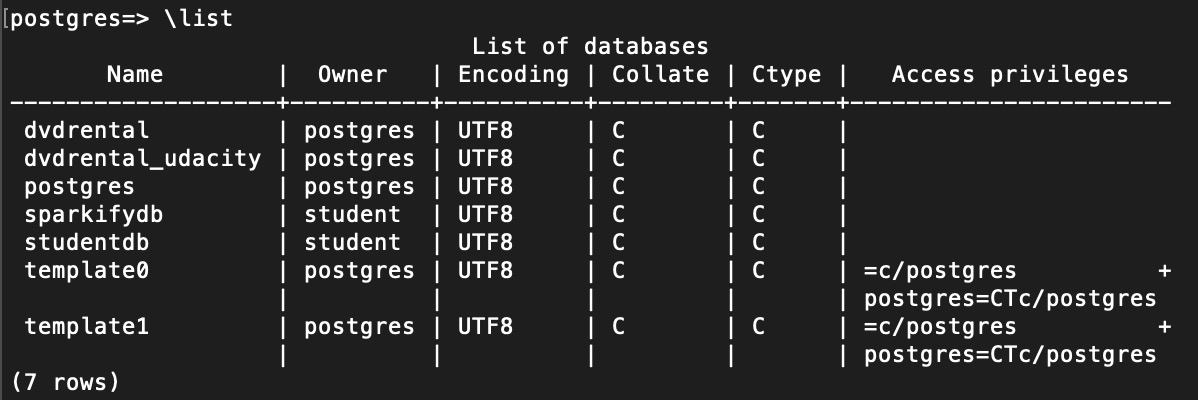Data Engineer Nanodegree Subproject
The repository contains the project information of the Data Modelling with Postgres from Udacity Nanodegree
Data Engineer. Please refer to the
course website for more details.
Project scenario: A startup called Sparkify wants to analyze the data they've been collecting on songs and
user activity on their new music streaming app.
Project goals: Build a database using Postgres and write an ETL pipeline to transfer raw data (JSON) to database tables for analytic purposes.
Business Process / Data Requirements
- Analytics team wants to understand what songs their users are listening to.
- Analytics team wants a Postgres DB with tables designed to optimize queries on song play analysis.
Engineering Task
- Create a Postgres DB schema and ETL pipeline for the analysis
- Explore & import raw data from JSON files given by the project
- Define fact & dimension tables for a star schema for this particular analytic purpose
- Write an ETL pipeline that imports and transfers data from JSON files to tables in Postgres DB
- Test database and ETL pipeline by running some test queires
Tools Used
- Python 3
- SQL
- Pandas
- Psycopg2
- Postgres DB
- LucidChart
Original Data Sources
Note that the actual data (in JSON) used in this project is a subset of original dataset preprocessed by the course.
Database Schema (Data Warehousing) Design
User Story: User user_id plays a song whose artist is artist_name at time start_time using agent.
From the above story, we can extract some necessary information/dimentions:
- Who: user dimension
- What: songs and artists dimension
- When: time dimension
- How (many): songplay fact
- (More possible dimensions but not used in this project):
- Where: geo-locations dimension
- How: agents dimension
Since the core business process/metric is an user playing a song, the fact table should store the song play records with
user/song identifier together with related information about the how and where the song is played. Based on the data and tables
given in the project, the star schema looks like this (generated using LucidChart):

ETL Process
- Extract songs data from corresponding JSON files and insert them into dimension tables:
- songs
- artists
- Extract users and time data from corresponding JSON files and insert them into dimension tables:
- users
- time
- Extract song play records from corresponding JSON files and insert them into fact table (and make sure to conform to entity relation constraints):
- songplays
- Test the entire ETL process and runing some queries.
Usage and Sample Results
Usage:
- Make sure all packages are installed and Postgres is configured with username student, see section Implementation Details/Notes below for more details.
- Execute
create_tables.pyto drop existing database and tables and create new ones. - Execute
etl.pyto run the ETL process and load data to database tables. - Open
test.ipynbin python notebook to verify results.
Additional files:
sql_queries.pyimplements all sql queries in this project including creating/droping tables, inserting records into tables, etc.etl.ipynbis a step-by-step guide to create the complete ETL process.
Some of the sample results after running test.ipynb:
Implementation Details/Notes
- Explicitly declear FOREIGN KEY to enforce referential integrity and improve performance, check this link
- Use Standard DataTime format:
YYYY-MM-DD HH:MM:SS.SSSSS - song duration (decimal, per song):
song_len <= 24 hours - latitude range (decimal):
-90 <= lat_val <= +90 - longitude range (decimal):
-180 <= long_val <= +180 - hour (int):
0 <= hour <= 23 - day (int, leap year has 366 days, the last day being at 365th):
0 <= day <= 365 - week (int, 52 weeks in total plus one/two days, ceiling to 53 weeks):
0 <= week <= 52 - month (int):
1 <= month <= 12 - year (int, the earliest recorded songs were made after 1800s according to wikipedia and
assuming artists and users in the database were not born before 1800s)
- year from songs table
year >= 1800oryear == 0(default if not specified) - year from time table:
year >= 1800
- year from songs table
- weekday (int):
0 <= weekday <= 6 - first/last name of users length:
1 <= len <= 100 - artist name length:
1 <= len <= 200 - foreign keys should not be
NULL, however it will result in producing only one record in fact table songplays. Therefore, relaxing the constraints to have only attributesstart_timeanduser_idasNOT NULLin fact table songplays.
Run project locally (Mac)
- Install Postgres Database
brew install postgresql - Check if Postgres is installed successfully
postgres -V
- Install packages
- Using pip command
pip install psycopg2
pip install pandas - Or Using conda environment
conda install psycopg2
conda install pandas
- Using pip command
- Check packages installed successfully

- (Re) Start Postgres services
brew services start postgresql
- Check Postgres Users/DBs
- Create a new user using following arguments:
- username: student
- number of connections (max): 8
- current username (with privilege of creating new users/roles): postgres
createuser -c 8 -d -P -U postgres student
Remember to set password as student
- username: student
- Create default database studentdb with owner/user student
createdb studentdb -U student - Verify the creation of user and database
- Now you can run the scripts and python-notebooks in this project
TODOs
- Use parallel processing to process songs data (take care of duplicate rows in artists and songs tables)
- Use parallel processing to process songplay data (take care of duplicate rows in users and time tables)
Resources
- Setup Postgres on Mac: Getting Started with PostgreSQL on Mac OSX
- Reading bulk data into Postgres: Fastest Way to Load Data Into PostgreSQL Using Python






